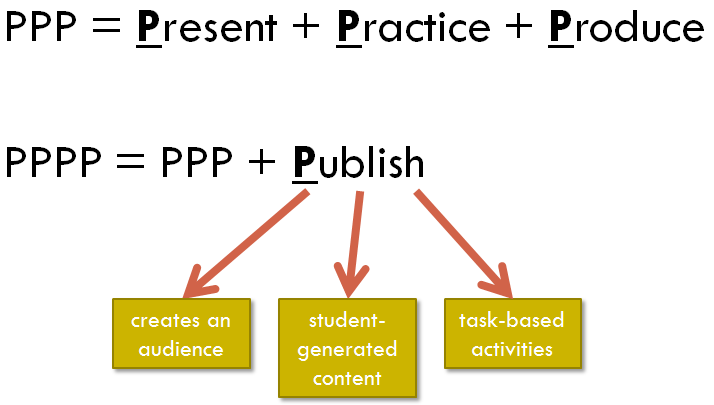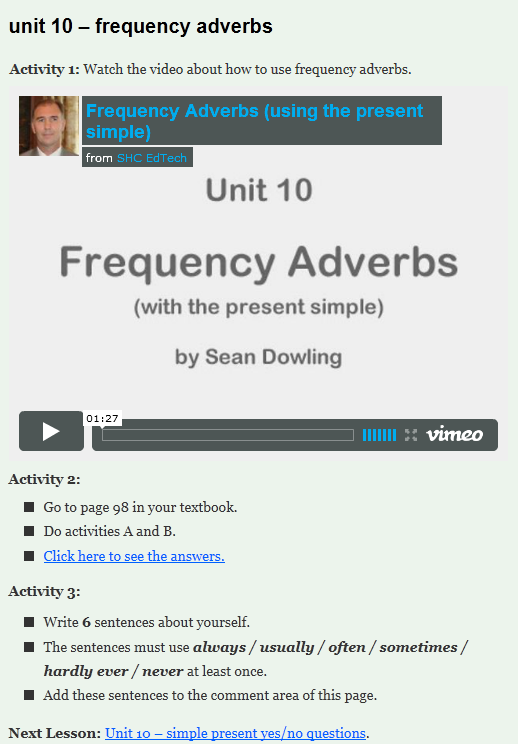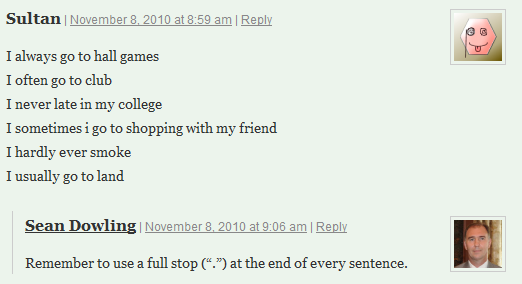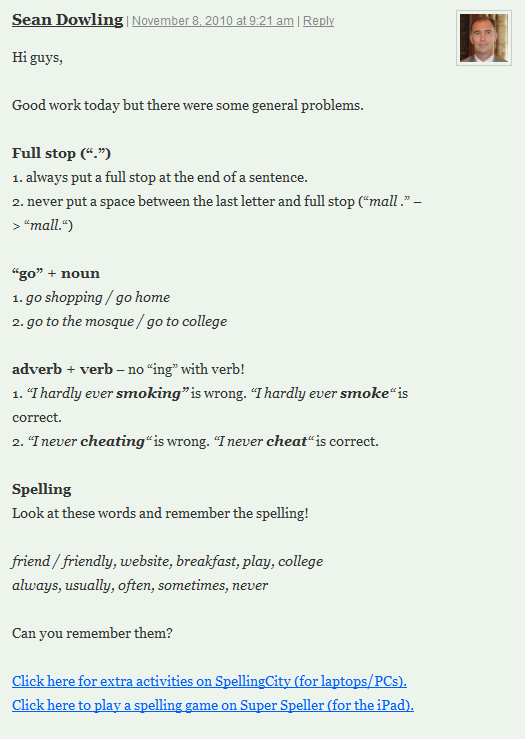 Sean Dowling, an Educational Technology Coordinator, looks at how to adapt the PPP model for task-based learning using digital tools.
Sean Dowling, an Educational Technology Coordinator, looks at how to adapt the PPP model for task-based learning using digital tools.
Despite many objections from the proponents of task-based learning (TBL), the PPP model, present + practice + produce, is still commonly used in education. One of the main objections is that the PPP model is too teacher-centric; educators should be presenting less and more emphasis should be given to students to acquire the required knowledge independently. However, the reality is that for a lot of students, particularly those with weak English language skills or those in the early stages of the learning cycle, there is still a need for content to be selected and presented using traditional, focus-on-form, methods. So rather than throwing out the PPP model, I try to use technology to enhance the model by adding an extra P, i.e. Publish. Not only does publishing motivate students by giving them an audience, it also allows the produced content to become a valuable learning resource for other students. In addition, the publishing stage can be designed to use activities that are more task-based in nature.

As an example, I will outline a lesson that I have used with a class of Emirati students studying in a university preparatory programme in the UAE. As the students in the class have weak English skills and the lesson is of the focus-on-form type, using the PPP model for the lesson is perhaps the most appropriate. All students in the programme have a computer (either laptop or iPad) so teachers are encouraged to use technology as part of the teaching process. My technological tool of choice is the blog. Not only do blogs allow me to present content that students can access anytime and anywhere, but the comment feature of blogs gives students an opportunity to contribute towards their learning. In the lesson outlined below (see figure 2, or click here for online version), the focus is on frequency adverbs.

This lesson is broken into six parts: PRESENT 1, PRESENT 2, PRACTICE, PRODUCE, PUBLISH and follow up.
- PRESENT 1: The teacher engages the students by using the pictures and text in the course book to introduce the grammar point implicitly.
- PRESENT 2: A video is used to explicitly focus on the grammar point. Students can, and do, watch the video as many times as they like. (Note: I used screenr.com to record the short video, which was then uploaded to my channel on vimeo.com).
- PRACTICE: Students do a controlled writing activity in the course book, checking their answers when finished. I usually allow students to work in pairs at this stage – it adds variety and it also stops students from referring to the answer sheet too quickly.
- PRODUCE: Students do a free writing activity from the course book. I give help to individual students if necessary.
- PUBLISH: Students publish their free writing as a comment to the blog post (lesson). As all comments are moderated, I can help students make corrections before the comments are made public (this helps put students at ease by decreasing the risk of ridicule from their classmates).
- Follow up: This is done after the class is finished. If a comment contains substandard work, I will email students to resubmit. However, this is rare as I try to get all students to complete the work in class time so most mistakes have already been caught. I also let some key mistakes go through, as I can then correct these and use the corrections to raise all students’ awareness (see figure 2). I will then add a general comment highlighting some common mistakes and adding links for extra practice (see figure 3). In a later class, we read over the student submissions and my general comments, and do the extra activities, in or out of class, depending on time.


There are a number of benefits to using a blog to deliver lessons in this way. First, students can proceed through the materials at their own pace; the teacher’s role becomes that of facilitator, able to spend more time personalizing the learning of both weaker and stronger students. This makes the lesson less teacher centred, a common complaint about the PPP model. Second, the comment feature of the blog enables students to become creators of learning content. As they know that their classmates will read their comments, they are thus motivated to produce better content. This content is also at the “just-right” level for their classmates, hence becoming a reinforcement of the language focus. Third, the students have anytime/anywhere access to the content, useful for review purposes or for students who are absent. Fourth, the format caters to the “flipped” classroom model. Students could watch the video and do the controlled writing before coming to class, thereby giving more time to work on freer writing activities in class. Finally, delivering lessons via a blog means that students have a record of class learning over a term or year. In addition, parents can also view what their children are learning and doing at school.
To finish off, it is important to note that lessons delivered via blogs don’t require students to have computers in the classroom. They could use smartphones to view the video and publish their work. Alternatively, as most students will have access to computers at home, flip the classroom and let them watch the video introduction at home before coming to class. During class time, students could work with the paper-based course book and other resources. The publishing of student work could also be done as homework.
Finally, publishing student work is not just restricted to PPP-style lessons; it could be used with all lesson types.


I think this is a good idea. I do something very similar and wrote a post about using a class blog ( @ https://authenticelt.org/2013/04/08/authentic-writing-keeping-a-class-blog-on-twiducate/ )
However, I don’t think it really helps to overcome any of the main objections to PPP, which are normally centered around the fact that PPP assumes that language consists of an itemised list of things which can be learned step by step. TBT proponents say this doesn’t reflect the nature of language or the nature of how languages are learned. I think that ‘PPP’ is always going to make these assumptions, no matter what comes before or after it. You’re still saying, for example, that today your students are going to learn ‘frequency adverbs’ and that by the end of the lesson, they will be better able to use adverbs of frequency – and this is the main problem for TBL. By ‘teacher centric’, I think TBL practitioners are talking mainly about the selection of language to be learned rather than the balance of activities / teacher talk in the classroom, which depends more on the teacher.
I’m not saying its not a good idea though – I think its a great idea! But for me, I would drop the ‘PPP’ part that came before the ‘publish’!
Hi Jonny,
Thanks for the comment. And you make a lot of valid and important points. I agree with you fully on the need to focus on publish. With the tech tools now available, we have so many opportunities to involve the students more in their learning.
However, I must also clarify the teaching situation that I was in. I was the “grammar” teacher for the students. This involved me teaching them 2 hours of grammar per week from the course book. Part 1 of the presentation was in fact done by the “reading/listening” teacher. So using an enhanced PPP lesson made sense. This wasn’t the fault of the course book, but more due to logistical/curriculum-related issues in the English programme. I think that these similar limitations still exist in a lot of EFL classrooms, hence the theme of the post.
In my next post, I will focus on how I have designed my own lesson with the aim of having students publish their work in their blogs, which will be read and commented on by their peers. It’s a similar process to which you describe in your blog post. The lesson is more task-based in nature (which I personally favour) with a heavy focus on sharing learner-generated content.
Sean
I had a professor who set up a class wiki on the school server. We had to do three blog posts a year, and then comment on three per assignment. It was nice to know others read the results of my hard work, and I enjoyed seeing what others wrote too. It helped me gain so many different points of view about the material.
Hi Jennifer,
Thanks for the comment. Creating an audience is important. Also, adding the posts and comments to your peers’ to the assessment criteria is crucial. But your professor sensibly kept things manageable with limited posts and comments. With large classes, having to post and comment too much can definitely lower the quality.
Sean
Reblogged this on web4learning.net.
[…] Sean Dowling, an Educational Technology Coordinator, looks at how to adapt the PPP model for task-based learning using digital tools. […]
Reblogged this on limfablog.
I could add publishing to production, don´t you? What is the main difeference?
Hi,
I feel that production, traditional, meant students producing work, in the classroom or at home, that stops at the teacher. I have added publish to refer to using web-based tools that allow student work to be shared, viewed and commented on by their peers.
Hope that explains thing.
Reblogged this on Victoria ELD and commented:
This is a great idea for writing class, or for those students who ask for writing homework.
Thanks for that. In the featured lesson, students have published their work in class time, but it certainly could have been done as homework. The comments are moderated by the teacher so nothing goes public unless properly vetted.
Very good presentation! The idea of publishing materials for and from students is very useful and building up instead of a type of form-centred lesson. They can create and become responsible for what they produce involving many skills from practical to ethic aims.
Thanks. Letting students be responsible for generating content has so many benefits, as you point out.
Hi Sean, thanks for a post that made me think.
I really like the extra ‘Publish’ step, as it encourages students to become actively involved and far more engaged than they normally would be in a lesson. I also like your step of correcting ‘most’ of the student errors, so weaker students won’t come to dread these tasks.
For the long term, could you pass on details of the students’ blogs to their future teachers, so as long as they are at your school they can keep building their blogs? It would seem like a great way to maintain consistency between classes and levels (and also for future teachers to see areas of improvement needed).
Thanks again!
Hi David,
In this post, students are commenting on the class blog. But I agree with your point about student blogs being a great way to maintain consistency between classes and levels. Students could post longer pieces of work on their own blogs, which over time would become a great record of their learning. It could also become a portfolio that could be shown to relevant parties in the future.
[…] way to create a wider audience is to post student work on blogs. In a previous post, I discussed how the comment area of a class blog post or page could be used by students to post […]